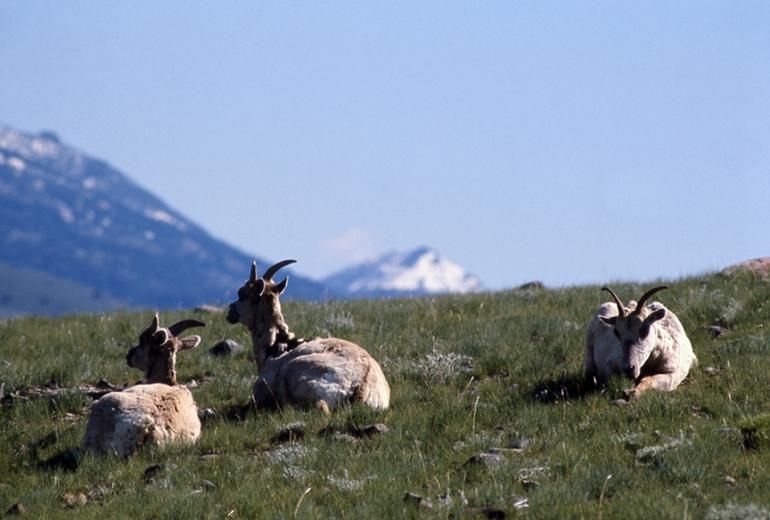Counting Sheep
Montana's horniest beast.
Southwest Montana is home to one of the country’s finest wildlife viewing opportunities: Rocky Mountain bighorn sheep traveling along the high crags, rock walls, and canyons. Naturalist John Muir was thrilled by the sight of this agile climber, and because of the bighorn’s ability to thrive in harsh conditions and steep terrain, Muir described the species as a symbol of mountain wilderness.
Bighorn herds are vertical migrators: they move down to between 3,000 and 6,000 feet as autumn snow arrives, and up to 9,000 feet in the spring. There, lambs are born on high ledges where most predators are unable to pose a threat. Within a week, ewes are leading their offspring along routes that look impassable to observers—a remarkable but anxiety-producing sight for anyone who spots them traversing the narrow ledges.
The bighorn breeding season takes place in the late fall, when rams weighing up to 300 pounds, (their horns that can weigh as much as 15 pounds each) battle for mates by colliding head-on at a speed of up to 20mph. Rams often suffer injuries in these contests, despite having several inches of bone and bony plates protecting their foreheads. Given the risk of injury and the tremendous energy expenditure, bighorns are known to reduce the frequency of serious battles by standing side by side, very close to one another. Biologists believe that the animals are visually comparing horn size, and that the smaller-horned ram then stands down—at least temporarily.
Today, the Rocky Mountain bighorn sheep is an indicator species of overall environmental health. It is extremely sensitive to changes in habitat, particularly changes caused by human activity—like the introduction of domestic sheep. Bacterial pneumonia that is carried and spread to bighorn by domestic sheep has decimated some of Montana’s bighorn herds over the last several years, and wildlife experts are currently working to reintroduce the animal to locations that have been most affected. One Montana Fish, Wildlife & Parks project proposed for 2015 involves transplanting 40-50 sheep from the Quake Lake area to the Wolf Creek drainage in the Madison Range.
Popular bighorn viewing areas include the Gardner River Canyon just inside Yellowstone’s north entrance (watch out for animals on the road), along Hwy. 89 between Livingston and Gardiner, and near the Big Sky turnoff on Hwy. 191. Other sheep viewing areas may be suffering from reduced population—visit fwp.mt.gov for current bighorn sighting information and species facts. The Yellowstone Association operates interactive wildlife sighting maps at the Bozeman airport and at the Yellowstone Association Visitor Center in Gardiner. The maps show recent bighorn sightings in the Park’s north end and around the Gardiner area.
—Barbara Lee











